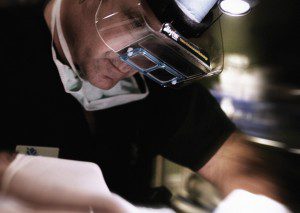Venous insufficiency, or leaky veins, is often the underlying cause of many seemingly unrelated symptoms.
By Joseph Magnant, MD, FACS –


“Years ago, I noticed that I was developing varicose veins in my right leg,” admits the 61 year old. “My mother had varicose veins and throughout the years, she had numerous operations to try and resolve them.” Manuel Avalos, Jr. confides that his nighttime leg cramping had become very severe.
Historically, the only treatment available to offer patients with venous insufficiency was surgical vein excisions, or vein stripping, which often required hospitalization and general anesthesia along with an extended recovery period.
“However,” continues Manuel, “I normally don’t like to go to doctors, so I just let it go.”
He says that his most recent job required extensive, long-distance driving: “As time went on, the veins in my leg were getting very big and very bulgy. My right ankle began swelling up. It looked black, red, and dark purple from my ankle up my leg for about six inches.
“Then I developed nighttime leg cramping. Friends recommended I try drinking a bit of vinegar, but it didn’t cure anything. I continued with my normal activities, but the cramping got worse. It was very painful. I would get out of bed and try to walk and stretch my leg, and eventually the pain would diminish, but the following day my muscles would be aching.
“I was having cramping at least twice a week and because of it I was in a lot of pain. I finally said to my wife, I need to take care of this.”
Manuel says his daughter accompanied him to see Joseph G. Magnant, MD, FACS, a board-certified vascular surgeon who specializes in vein treatment. His practice, Vein Specialists at Royal Palm Square in Fort Myers, is 100% dedicated to the modern evaluation and treatment of leg vein disorders.
“Manuel presented with extensive problems in his right leg,” remembers Dr. Magnant. “In his case, his venous insufficiency was visually obvious, with bulging veins and his swollen, discolored ankle. However, patients with venous insufficiency don’t always have external signs. They may present with leg cramping or heavy, tired, or fatigued legs, but no visual symptoms.”
What is venous insufficiency?
Dr. Magnant describes venous insufficiency: “Healthy leg veins typically have a series of valves that open in one direction, allowing for flow in a segmental fashion from the feet up toward the heart. When the valves no longer close tightly, venous blood refluxes back down toward the feet, resulting in increased pressure in the leg veins, which can lead to many symptoms including leg swelling and aching, skin discoloration, leg ulcerations, and excessive nighttime urination. If not treated, the skin can become so thinned out, or effaced, over time that even hot water may cause the skin to begin bleeding, and venous insufficiency can also lead to thrombosis, or clotting of the veins, which can advance to a potentially life-threatening pulmonary embolism.”
Dr. Magnant explains that diagnostic ultrasound is a very accurate, conservative, and noninvasive diagnostic tool that is the gold standard in making the diagnosis of venous insufficiency: “We rely heavily on ultrasound evaluation of our patients’ veins.
“With ultrasound, which is usually covered by patients’ health insurance, we can determine the exact source of the problem,” assures the Dr. Magnant. “We can see exactly which veins are leaking, and then design a game plan to solve the problem.”
Manuel’s ultrasound confirmed that he had venous insufficiency in his right leg.
“Unlike in the past, today leaky superficial veins can be treated with a choice of minimally invasive, in-office procedures,” assures Dr. Magnant. “In 1999, the first FDA-approved system was the radiofrequency-based closure system designed by VNUS Medical Technologies.
“It was really a game changer in terms of treating patients with venous disease.”
Inserting a small caliber, sophisticated catheter into the vein through a small needle prick, RF energy is transmitted through the device, heating the vein in segments to seal the vein walls with little discomfort to the patient, informs Dr. Magnant: “Once the ablation takes place, which, on average, takes approximately fifteen to twenty minutes, the catheter is removed.
“Subsequently, the body re-routes blood through healthier leg veins, restoring normal circulation.”
Then, in 2001, the first laser-based system was approved, and other laser companies followed suit with various wavelengths, says Dr. Magnant: “This procedure is often referred to as endovenous laser treatment, or EVLT, and is slightly different in technique from radiofrequency in that its catheter is retracted continuously rather than segmentally.
“We offer both the Venefit™ procedure [formerly called the VNUS Closure procedure] and Cooltouch Laser for EVLT because each system has its place in the treatment of patients with venous disease. Both the Venefit and laser systems allow us to treat patients in the office without anesthesia risks, and patients can return to normal activities almost immediately.”
For Manuel, Dr. Magnant performed laser endovenous ablation of the right great saphenous vein on December 12, 2012.
Successful outcome
According to Manuel, he has not had any leg cramps since his procedure.
Dr. Magnant explains that when veins are leaking significantly, the normal pressure in the veins around the ankles can escalate from a normal 10 to 15 mmHg to as high as 80 mmHg: “Once the pressure is relieved, the cramping stops.”
“I love Dr. Magnant,” states Manuel. “I feel very good now. I went bicycling this morning wearing shorts. There is a huge comparison between how my leg looked before and after the procedure. I don’t see any varicose veins.”
Vein Specialists At Royal Palm Square | 239.694.8346 | weknowveins.com | facebook.com/weknowveins
 Southwest Florida's Health and Wellness Magazine Health and Wellness Articles
Southwest Florida's Health and Wellness Magazine Health and Wellness Articles

